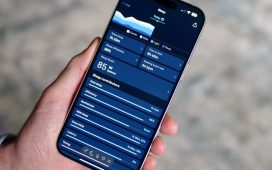
Moments before one of the largest underwater volcanic eruptions smothered the Pacific island of Tonga, a strange signal happened.
Hunga Tonga-Hunga Ha’apai erupted in January 2022, creating an explosion equivalent to hundreds of atomic bombs.
Hunga shook the region so violently it caused a deadly four-foot tsunami into Tonga’s capital, Nuku’alofa, and spewed a plume of gas and ash up so high it was visible from space.
But researchers have discovered that 15 minutes before Hunga blew its top, two faraway monitoring stations recorded a seismic wave that was an warning sign of the catastrophe to follow.
This ‘seismic precursor’ and the subsequent eruption were caused by a weak section of the ocean floor below the cauldron-like hollow Hunga sat inside collapsing, according to the findings published in Geophysical Research Letters.

When all seawater flooded into the gap a few hundred metres below sea level, it crashed into the superhot magma, causing the water to flash violently into steam.
Researchers found this caused a Rayleigh wave. It’s not a ‘wave’ in the surfboarding sense, but rather an acoustic one that causes the ground to roll almost like the motion made when you layer on your bedsheets.
‘Many eruptions are preceded by seismic activity,’ said lead author Takuro Horiuchi, a volcanology graduate student at the University of Tokyo.
‘However, such seismic signals are subtle and only detected within several kilometers of the volcano.’
This Raleigh wave, usually known for their leisurely but destructive movement, was felt hundreds of kilometres away.
‘We believe unusually large movements started at the time of the precursor,’ he added.

Why is this important? Volcanic eruptions often start with a lot of underground mumbling months before – in Hunga’s case, it was December 2021.
But all of this happens where humans can’t see, leaving some mechanics of geological mechanics a mystery. Even the smallest indication that an eruption is imminent can save lives, which is why the University of Tokyo researchers rifled through all the data around the Hunga eruption.
Co-author Mie Ichihara, a volcanologist at the University of Tokyo, said: ‘Early warnings are very important for disaster mitigation.
‘Island volcanoes can generate tsunamis, which are a significant hazard.
‘At the time of the eruption, we didn’t think of using this kind of analysis in real-time. But maybe the next time that there is a significant eruption underwater, local observatories can recognize it from their data.’
The January 15 Hunga eruption only lasted only about 10 minutes or so, but its impact was felt far and wide – and high.
The eruption had a Volcanic Explosivity Index (VEI) rating of at least VEI-5, roughly the same as the eruption of Mount Vesuvius in 79 CE.
Hunga’s blast caused a booming sound so loud that it was heard some 1,100 miles away in New Zealand, with the shock wave reaching 60 miles high well beyond the stratosphere, or upper atmosphere.
As did the tower of ash it coughed up, that reached a record-breaking 35 miles high.
Satellite sensors in the days that followed measured about 400,000 tons of sulphur dioxide. About 146 million metric tons of water vapour was chugged out, enough to fill 58,000 swimming pools.
The volcano, only 40 miles from the main island of Tonga, Tongatapu, also pushed out tsunamis towards the Atlantic, Caribbean and Mediterranean.
The tsunamis killed at least four people in Tonga and a further two thousands of miles away in Peru.
Only some parts of the remote nation were left, including slithers of Hunga Tonga and Hunga Haʻapai.
Get in touch with our news team by emailing us at webnews@metro.co.uk.
For more stories like this, check our news page.
MORE: What is methanol and why is it deadly to humans?
MORE: This pasta is 200 times thinner than a human hair
MORE: Here’s what Nasa are planning to do with asteroid worth $10,000,000,000,000,000,000












